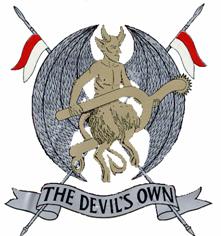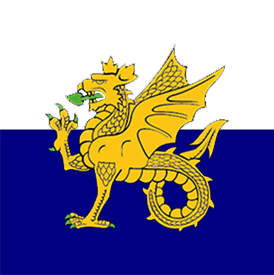
The Royal Corps of Signals is one of the combat support arms of the British Army. Signals units are among the first into action, providing the battlefield communications and information systems essential to all operations. Royal Signals units provide the full telecommunications infrastructure for the Army wherever they operate in the world. The Corps has its own engineers, logistics experts and systems operators to run radio and area networks in the field. It is responsible for installing, maintaining and operating all types of telecommunications equipment and information systems, providing command support to commanders and their headquarters, and conducting electronic warfare against enemy communications.

The 33rd Signal Regiment was a British Territorial Army regiment of the Royal Corps of Signals.

The Inns of Court & City Yeomanry is a British Army unit formed through the amalgamation of The Inns of Court Regiment and The City of London Yeomanry in 1961. Its lineage is maintained by 68 Signal Squadron and the Band of the Royal Yeomanry.
The Queen's Own Warwickshire and Worcestershire Yeomanry (QOWWY) was a regiment of the Royal Armoured Corps, forming part of the Territorial Army (TA). Following reductions in 1969 and 1971 respectively the regiment was reduced to two and later one company sized sub-unit in 1999. Following a reorganisation in 2021, there are now two successors to the regiment: one squadron in the Royal Yeomanry as light cavalry, and one squadron in the 37th Signal Regiment as a support squadron.

The 2nd Signal Brigade, was a military formation of the British Army composed of Royal Corps of Signals units. The brigade was first formed following the reorganisation of the old Territorial Army in 1967, and was disbanded in 2012 under the Army 2020 programme. However, later the 2nd Signal Group was formed continuing the lineage of the old brigade, before it was disbanded in 2018.

562 Parachute Squadron Royal Corps of Transport (Volunteers) was a minor unit that supported 44th Parachute Brigade (V).

36 (Eastern) Signal Regiment was a Territorial Army (TA) signal unit of the British Army's Royal Corps of Signals (RCS). The regiment was formed following the formation of the TAVR in 1967, and was disbanded in 2009 following a reorganisation in the RCS. Though not disbanded, the regiment continues its lineage as a squadron, with its own former squadrons forming troops within said squadron.

The 31st Signal Regiment was a territorial communications regiment of the British Army's Royal Corps of Signals. The regiment first formed following the creation of the Territorial and Army Volunteer Reserve in 1967 after the 1966 Defence White Paper. After seeing limited reserve support during the Cold War, the regiment was disbanded in 2010 following the initial Army 2020 reform.

34 (Northern) Signal Regiment was a Territorial Army regiment in the Royal Corps of Signals in the British Army. The regiment formed part of 12 Signal Group, providing command and control communication for NATO's Allied Rapid Reaction Corps (ARRC). As a result of the Strategic Review of Reserves it was announced on 28 April 2009 that the regiment was to be disbanded The regiment consisted of three squadrons plus the band:

37th Signal Regiment is a military communications regiment of the Royal Corps of Signals, part of the British Army. The regiment was one of ten Territorial Army,, units formed following the complete reorganisation of the Territorial Army in 1967. Until the Army 2020 programme in 2012, the regiment provided national communications support and its squadrons providing support to the regional brigades, notable 143rd and 160th (Welsh) Brigades. However, from 2014 the regiment was re-roled and now paired with 2nd Signal Regiment supporting 1st Division.
The 38 Signal Regiment (Volunteers) was a regiment of the British Army's Royal Corps of Signals, part of the Army Reserve. The regiment's task was to "provide contingency communications throughout the whole of Northern England, from the Scottish Borders to the Northern Home Counties. In this role it provided direct support to 15th Brigade, the Preston-based 42nd Brigade and the Nottingham-based 49th (East) Brigade." The regiment formed part of 2 Signal Brigade.

The 11th Signal Brigade and Headquarters West Midlands is a signal formation of the British Army's 3rd UK Division. Its headquarters is located at Venning Barracks, in Donnington in Shropshire.
The Northern Army Group (NORTHAG) was a NATO military formation comprising five Army Corps from five NATO member nations. During the Cold War NORTHAG was NATO's forward defence in the Northern half of the Federal Republic of Germany (FRG). The Southern half of the Federal Republic of Germany was to be defended by the four Army Corps of NATO's Central Army Group (CENTAG). During wartime NORTHAG would command four frontline corps and one reserve corps. Air support was provided by Second Allied Tactical Air Force.

The 1st Signal Brigade, formerly known as the 1st Signal Group, is a brigade of the British Army. The group was first formed in 1968 as a result of the 1966 Defence White Paper which expanded support for NATO and the British Army of the Rhine. In 1987 the group was disbanded and merged into the 2nd Signal Brigade. In 1995 the brigade was reformed and has since deployed on operations across the globe in support of NATO and HQ Allied Rapid Reaction Corps.

The 12th Signal Brigade, later 12th Signal Group was a military communications formation of the British Army commanding regiments of the Royal Corps of Signals. Initially formed in 1967, the brigade would provide rear defence communications for the British Army of the Rhine until its disbandment in 1992. In 2004, the group was reformed to provide territorial army and rear support to the Allied Rapid Reaction Corps in Germany. However, in 2009 the group was disbanded following reductions to the Royal Corps of Signals and Territorial Army.
The 4th (Volunteer) Battalion, The Worcestershire and Sherwood Foresters was a former territorial infantry battalion that existed for a short time towards the end of the Cold War. Following reductions to the Territorial Army (TA) in 1992, the battalion was disbanded with elements helping to form RHQ & HQ Sqn of 37 Signal Regiment, and 96 Signal Squadron. This squadron was then reduced to a signal troop in 2009, but continues to exist as part of 48 Signal Squadron.

85 (Ulster) Signal Squadron was a military communications unit of the British Territorial Army, which formed part of the Royal Corps of Signals. The squadron was one of four signal squadrons which formed part of 40th (Ulster) Signal Regiment until its disbandment in 2009.

The 9th Special Communications Unit, later redesignated as the 92nd Signal Regiment, and from 1967 as 2 Signal Squadron is a communications unit of the British Army, belonging to the Royal Corps of Signals.

48 Signal Regiment was a Territorial Army (TA) unit of the British Army's Royal Corps of Signals from 1920. It had its origins in a Volunteer unit of the Royal Engineers formed in 1861 and provided the communications for several infantry divisions during World War II. Postwar it went through a number of reorganisations. Its successor still serves as a squadron in today's Army Reserve.









